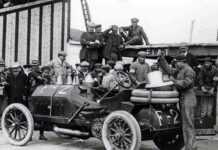Today, the Ford GT40 remains one of the most iconic and recognisable sports racing cars of any era, its distinctive shape being recreated over the decades by numerous builders of replica automobiles to supply a demand that remains some sixty years since its conception. However, it is worth recalling the original distinctive shape of first Ford GT prototype, chassis GT/101, that made headlines when it was unveiled on 1st April 1964.

The motoring press eulogised over its deceptively simple, elegant lines that were considered futuristic at the time. Many declared it the most beautiful race car ever, as the photograph above illustrates. It was constructed by Ford Advanced Vehicles in the UK in just 16 days around a chassis supplied by Abbey Panels of Coventry. The project manager, John Wyer, was anxious to begin testing as a matter of urgency as Ford had set the forthcoming Le Mans 24-Hour race as its first competitive outing. Its press launch was held in a hotel near Heathrow airport since, despite an impossibly tight schedule, Ford made the decision to fly the car to New York for an official American launch in the Essex House Hotel.
The press photograph was taken on the JFK airport tarmac shortly after GT/101 had landed, between being unloaded and whisked off to the hotel. It returned to the UK the following day and sent to the MIRA facility for initial assessment, followed by a handful of laps at Silverstone prior to its appearance at the Le Mans test weekend in mid-April. As with so many things in life, beauty can be deceptive and GT/101 experienced the shortest race career of any GT40 when it demonstrated a lack of downforce. In 1964 the importance of aerodynamics was beginning to be appreciated and while its elegant front end was admired on aesthetic grounds, it proved better suited to an aircraft as the car ‘took off’ when approaching top speed along the Mulsanne straight and left the circuit. Its driver Jo Schlesser, survived unscathed but a decision was made to scrap the badly damaged prototype rather than spend valuable time rebuilding it. It took over year before the GT40 finally acquired its distinctive nose shape which was still shaped by intuition but within a few years it would be computers and wind-tunnels that dictated race car design.










